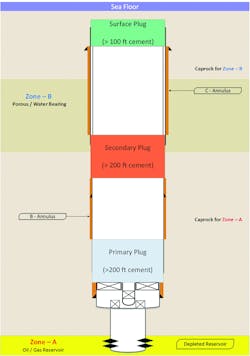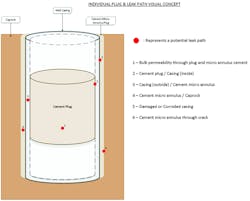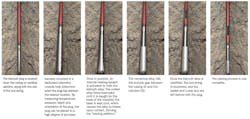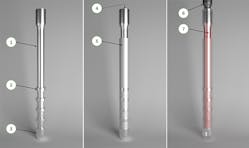Globally referred to as plugging and abandonment (P&A), the decommissioning of depleted oil and gas wells involves the insertion of plugs downhole to seal the reservoir. The objective is to prevent surface leakage and cross contamination and to return the integrity of the caprock — penetrated when the well was first opened — to a predrilled state.
Plugging and abandonment is completed almost exclusively by the application of cement slurry, typically with three cement plugs inserted at different depths in the wellbore to achieve a secure seal. The process consumes hundreds of feet of cement, can cost hundreds of thousands of dollars per well, can take several days to complete, and, offshore, requires the use of a rig. The three cement plugs in the P&A process follows the requirements in the U.K., Norway and the U.S. for plugging: namely, a primary plug above the depleted reservoir, a secondary plug (that can also form a continuous seal with the primary plug), and a surface plug sitting beneath the seabed (see Figure 1). The plugging process is designed to create a permanent barrier, reaching across the well and securely enclosing downhole fluids and gases. For the North Sea, industry trade association Oil & Gas UK specifies a design life of 3,000 years for plugs.
Figure 1. Three cement plugs in the P&A process
Although cement is the most widely used abandonment medium both onshore and offshore, cement plugs have been found to fail over time, primarily as a consequence of microcracks and the subsequent permeability, resulting in gas leaks. There are, however, various causes of failure. For example, leakage can occur through percolation pathways that formed when the cement plugs were curing. Leakage can result from cement shrinkage, reducing overall seal integrity. Leakage can also occur around the plug and through the formation of secondary pathways, such as cracks or damaged annulus cement (see Figure 2).
Figure 2. Cross-section showing possible routes to leakage
The leakage of downhole fluids and gases not only poses an environmental risk, but also presents a significant financial burden for the operating companies that, in the event of plug failure, would be exposed to additional reabandonment and replugging costs. Furthermore, re-entry into a wellbore following plug failure is a challenging process due to the length of the cement plugs used, which can be up to 500 feet in length.
The metal alloy alternative
For an alternative plugging medium to cement, structural metal alloys — being developed by U.K.-based Rawwater Engineering Company Limited, which invented the Bismuth Plug — are strong, formable and impermeable to withstand the rigors of both onshore and offshore applications, and the plugs are capable of operating effectively from shallow to deep wells. The development of structural bismuth alloys (as opposed to off-the-shelf eutectics) presents the opportunity for a reassessment of current approaches to well abandonment in particularly challenging applications. The advantages of using this type of bismuth alloy include enhanced long-term plug integrity, longer plug life and reduced deployment costs — a factor that is even more significant offshore. Compared to the lengthy setting time associated with cement plugs, which takes days to complete, the deployment of metal alloy plugs is undertaken in a matter of hours (see Figure 3). As the need for a rig vessel is negated, deployment savings are also accentuated.
Figure 3. Rawwater’s bismuth plug casting process
Rejecting common bismuth alloys and through a £1 million developmental program, Rawwater has produced a suite of proprietary expanding metal alloys for use as high-integrity seals in oil well abandonment. The alloy properties of low melting point and expansion upon solidification are exploited to cast seals in-situ, but without the inherent creep issues typical of bismuth tin. The seals are also highly resistant to corrosion and have a certified 3,000-year-plus life expectancy even in harsh environments. The technology can be applied in a range of other industries and situations where a high-integrity seal is required for difficult and demanding situations.
Why bismuth?
Bismuth has the unusual property of expanding when solidifying, similar to water expanding when freezing to become ice. Bismuth can be combined with various other metals to produce a wide range of fusible (low melting temperature) alloys.
Once molten, bismuth alloys have a very low viscosity, allowing them to conform to the profile of any surface they come in contact with. When expanding bismuth comes in contact with the inside diameter of the wellbore casing, a large contact load is generated, which leads to the forming of an ultra-high integrity metal-to-metal seal. The bismuth casting process takes only hours. For comparison, a 3-foot (0.91 meter) bismuth plug can outperform a conventional cement seal, which may be up to 500 feet (152 meters) in length (see Figure 4).
Figure 4. Rawwater’s bismuth plug anatomy: 1. Mandrel | 2. Mandrel rib | 3. Mandrel skirt | 4. Internal heater (cold) | 5. Bismuth alloy reservoir | 6. Cross-over adaptor | 7. Internal heater (hot)
Low-melting-point alloys such as bismuth can be applied easily with little heat input to the substrate — generated either by an electric charge or by the use of a pyrotechnic device, dependent on depth — and have the property of expanding on solidification to form a tight seal on almost any surface. The low viscosity of the molten alloy enables penetration into porous substrates with pore sizes as small as 25 microns, with expansion on solidification giving a gas-tight seal. The high density of the alloy displaces water to enable sealing underwater or against large leaks, while also being easily removable if necessary, or if the output from a well was merely being suspended at the time of plugging.
Offshore capability
In 2010, as a demonstration, Rawwater deployed bismuth alloy seals in two onshore wells in Alberta, Canada, at a 1,000-foot depth and 1,000 psi pressure differential. The bismuth tin eutectic alloys used in this initial application, however, offer limited applicability, especially offshore. To develop offshore capability and reliability, the company completed a two-year program to deliver 7-inch plugs for deployment in the North Sea, rated to 6,000 psi differential pressure at 60 centimeters (2 feet) in length. Extensive development and testing have been conducted in collaboration with an operator consortium to develop the formulation of the metal seals. The qualification of the alloy has included material testing, thermal modeling, stress testing, accelerated corrosion testing and compatibility testing with casing materials.
Strict technical qualification
Having undertaken onshore deployment trials of a number of novel alloys specifically formulated for plugging and abandonment, Rawwater needed to establish the mechanical properties and creep behavior of the alloy as a simulation under service pressure and temperature conditions. To achieve this, the organization partnered with the University of Aberdeen and, through an OGIC-funded (Oil & Gas Innovation Centre) partnership, determined the alloy’s creep parameters at stress and temperature conditions similar to those experienced downhole. The result is a suite of alloys for onshore, offshore and subsea plugging and abandonment, with operating envelopes to cover downhole geothermal temperature conditions from 158°F to 194°F (70°C to 90°C) and 284°F to 320°F (140°C to 160°C). These alloys have been subjected to a strict technical qualification program overseen by Bureau Veritas, with stringent adherence to the qualification processes stipulated by DNV-RP-203 – Jul 2013, ISO 14310 (V0) and Oil & Gas UK. They are intended as a cost-effective alternative for sealing well abandonments and resealing failed abandonments that were previously plugged using cement. The application includes both casing plugs and plugs/seals in undefined and/or rough walled geometries (e.g., caprock) that are difficult to seal with existing technologies such as cement.
“The advantages of using this type of bismuth alloy include enhanced long-term plug integrity, longer plug life and reduced deployment costs — a factor that is even more significant offshore.”
As part of the initiative, Astrimar, an independent U.K.-based specialist engineering consultancy, is developing predictive well integrity modeling software to forecast future plug performance, reflecting the specific downhole well and casing conditions and plug material behavior. These predictions will support well risk assessments and provision of plug reliability assurance, as well as support the definition and analysis of Rawwater’s qualification testing activities. In-house, Rawwater formulates the new alloys and test these alloys in custom autoclaves and downhole-simulated temperature-controlled pressure chambers to replicate as close as possible the conditions seen in service.
Conclusion
Bismuth alloys present an opportunity for the reassessment of the current approaches to plugging and abandonment. These plugging solutions may significantly reduce deployment costs, particularly when used subsea.
Dr. Bob Eden is managing director of Rawwater Engineering Company Limited and serves as a technology developer for the oil industry, with activity in the exploitation of innovative technologies for Shell International and BP. Before establishing Rawwater, Dr. Eden worked at UMIST (University of Manchester Institute of Science and Technology), developing technologies over 15 years in the fields of explosive cutting and cladding, corrosion, subsea engineering and well technology. His oilfield technology has included the development of subsea reservoir injection systems, bismuth alloy well-sealing technology for plugging and abandonment and the development of forecasting tools for oilfield reservoir souring.







